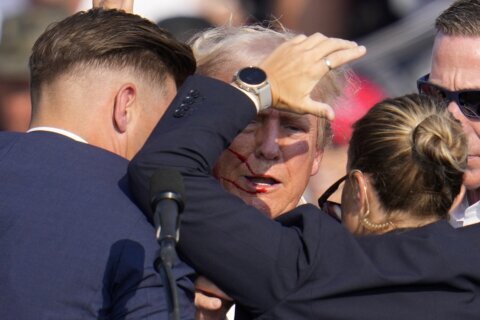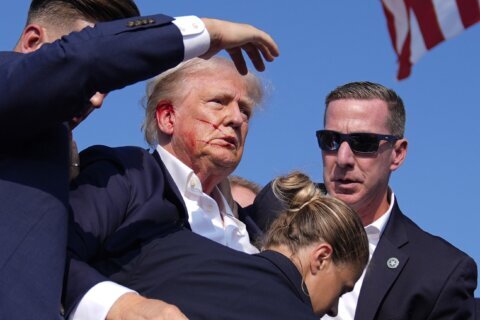WASHINGTON — Sixteen years after the worst terror attack in U.S. history, a former senior operations officer with the CIA believes, “the situation is even worse.”
Mike Maness was overseas when the 9/11 attacks took place.
Coordinated attacks, plotted and launched by terror group al-Qaida, struck New York’s World Trade Center and the Pentagon, just outside D.C., using hijacked planes. A third plane, believed to be intended to strike the U.S. Capitol, was deliberately brought down by heroic passengers in Shanksville, Pennsylvania.
In all of the attacks 2,996 people were killed and more than 6,000 were injured.
Americans responded with anger, defiance and solidarity.
“I was stationed overseas as a Deputy Chief of Station for the CIA. I didn’t get to witness the upswell of patriotism and unity that apparently occurred in the immediate aftermath of the attacks,” said Maness.
By the time he returned to the U.S. in the summer of 2002, the outward displays were fading.
“The American flags that decorated people’s front yards and the ribbons tied to automobile antennas had mostly disappeared. I encountered many people who appeared eager to put 9/11 in the rearview mirror.”
For him, that was a troubling development.
“Given that I had just spent six months working nonstop to help capture the perpetrators and planners of the attack, this attitude surprised me,” Maness said.
Now director of TrapWire, a global threat detection firm, Maness thinks the U.S. has become numb to the insidious nature of terrorism.
“As a country, we tend to have a very short memory. The average citizen seems to have forgotten, or is choosing to ignore, the fact that terrorism is still a very real threat,” he said.
There have been at least nine terror attacks in the U.S. in 2017 as of Aug. 9. Seven people were killed.
It’s a far cry from the near 3,000 that died on 9/11, though no less painful for their families or problematic for authorities trying to stop it.
According to federal authorities, of the nine attacks, only two were clearly identified as jihadist extremism. Four were based on racial hatred. One was politically motivated, and one was not clearly defined.
The tactics, tools and underlying ideology employed in recent attacks were also vastly different from the behemoth airplanes used 16 years ago to plow into buildings during synchronized attacks.
Four of the attacks this year involved guns — in Denver, Colorado; Alexandria, Virginia; Fresno, California and Kansas City, Missouri. Explosives were used in two attacks in Bloomington, Minnesota, and Tulsa, Oklahoma. Two people were stabbed with knives in New York City and Flint, Michigan, and one car was used to kill a woman during a protest in Charlottesville, Virginia.
The common denominator is a departure from large, sophisticated attacks to more simple and low-tech methods.
“They will often use whatever tools or capabilities that are easily within their grasp, whether that’s a knife or a gun or increasingly, vehicles. Some of that comes from their own initiative, but some of that comes from instructions and guidance they’ve received from overseas from organizations like ISIS,” Nick Rasmussen, director of the National Counterterrorism Center told WTOP in a recent interview.
Even though the attackers may hold diametrically opposed views, they have used similar tactics.
U.S. authorities worry radical Islamic extremism, the foundation of the 9/11 attacks, is shifting to more discrete platforms, namely encrypted social media technology. The shift has fueled homegrown violent extremism (HVE).
Nikita Malik, Senior Research Fellow at the Henry Jackson Society in London, believes increases in HVE are perhaps the most significant changes in terrorist tactics since 9/11. And it’s because of D’aesh or the Islamic State of Iraq and the Levant (ISIS).
“It’s because individuals who cannot go to Syria and Iraq are encouraged to do whatever they can in bringing as much chaos as they can to the countries they live in against the Kuffar, or disbelievers, who are not Muslims,” he said.
London has been rocked by four terror attacks this year.
“The period in which these attacks have happened and the methods used are extremely troubling. What is even more troubling are the numbers. In the United Kingdom, we’ve had 850 fighters who have traveled to Iraq and Syria, of which half — approximately 400 to 450 people — have returned to the United Kingdom, and they are British citizens,” Malik said.
Their British passports, according to Malik, coupled with violent tendencies, present a real threat to U.K. society “because they are radical enough to go out and join these jihadist groups, but then on top of that you have people who have not joined but who empathize and believe in the cause of violent ideology.”
A U.S. intelligence official told WTOP the biggest difference between 9/11 and now is that the predominate terrorist organization and threat is ISIS and not al-Qaida.
“Al-Qaida still exists with the remnants of its core residing in the Afghanistan/Pakistan (AF/Pak) border region specifically and it’s nodes in places like Syria and Yemen. But we’ve also seen the nature of how a terrorist organization works, changes, because of the more diffuse, low-level attacks that ISIS employs versus the spectacular attacks that al-Qaida leaned toward,” the official said.
According to the official, some of the lessons learned from how to defeat al-Qaida can be applied to ISIS.
“Just like we put pressure on core al-Qaida in the AF/Pak region and limited their abilities to conduct those large scale attacks, we are now in the U.S. government putting pressure on ISIS and depriving them of a similar safe haven, which is not a determinative step, but a necessary step to limiting their ability,” said the official.
Because of ISIS’ lightning fast emergence as the pre-eminent terror organization, according to the official, the organization “seemed to take over the way we think about terrorism from al-Qaida. It masked or minimized an important fact — that we were and continue making significant progress against al-Qaida.”
The official said some believe “that fighting terrorism is hopeless and we’ll never get anywhere, but that there are in fact models for defeating terrorism and we are pursuing those.”
According to Rasmussen, there is proof of that.
“There is no question that we’ve made tremendous progress in our effort to shrink the size of the caliphate; to squeeze ISIS leadership into smaller and smaller spaces, put more pressure on them and make it more difficult for ISIS leadership to organize attacks in various locations around the world,” said Rasmussen.
But the fight never stops.
“There are no permanent defeats and no permanent victories,” said Robin Simcox, Margaret Thatcher Fellow at the Heritage Foundation.
He said U.S. efforts to destroy ISIS’ so called caliphate, work with global partners on counter terrorism solutions and collect valuable intelligence must continue, but he acknowledges it’s impossible to stop every attack.
“If a radicalized individual is looking to get a truck and drive over civilians, there’s a limit to what the U.S. do about that.”
Simcox said, however, early intervention is the key. Evolving technology and people are expected to make the difference in the coming years.
“I’m confident that we’re going to be able to hire and train and keep and retain the very best and brightest young people who want to serve in the national security world and want to serve their country,” Rasmussen said.
All of the officials and experts WTOP spoke to concede that no amount of technology or human dedication can cover what Maness fears — complacency.
“After almost 20-years of working against these groups on behalf of the U.S. government, I can assure you, if there is even the slightest chance of repeating 9/11, our adversaries will take it. For the time being, they’ll content themselves with using vehicles and knives to achieve the same psychological impact — until something bigger comes along,” Maness said.







